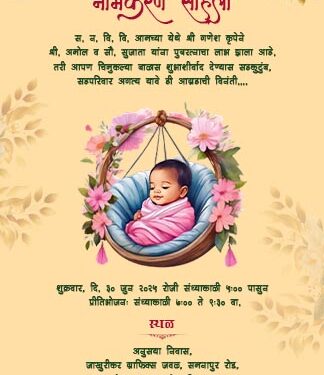Welcoming a newborn is one of the most joyful and spiritually meaningful experiences in Indian culture. For Maharashtrian families, the Namkaran Sohala or naming ceremony is a sacred event that symbolizes the child’s official entry into the family and society. To invite loved ones to this heartfelt ceremony, a thoughtfully designed Namkaran invitation card Marathi becomes a key element, reflecting tradition, warmth, and cultural connection.
The Significance of Namkaran Sohala in Marathi Culture
The Namkaran Sohala usually takes place on the 12th day after the baby’s birth, although some families consult astrologers for an auspicious date based on the baby’s nakshatra (birth star). This event involves family members, a priest, and close friends gathering to bless the child with a name believed to shape their destiny.
Traditional rituals are performed, including a puja, havan, and mantra chanting, to seek divine blessings. The baby is dressed in new clothes and placed in a cradle adorned with flowers. The chosen name is whispered in the baby’s ear by the father or elder and then announced aloud to the family and guests. This marks the baby’s formal introduction to the world.
Why Choose a Marathi Invitation Card
Language is a powerful expression of love and identity. A Namkaran invitation card in Marathi helps preserve the rich cultural heritage of Maharashtra. It speaks directly to elders and relatives who feel more emotionally connected when invited in their native language.
1. Antim Sanskar Card in English for Funeral Invitations
In times of sorrow, sending a heartfelt antim sanskar card in English helps inform relatives and friends with dignity. These cards are used to announce the passing of a loved one and invite people to attend the last rites. Whether the ceremony is traditional or modern, a respectfully designed card can convey both the details and the emotions tied to the event.
2. Design Your Own Antim Yatra Card with Personal Details
Creating a personalized antim yatra card helps communicate the final journey details clearly. You can include the name of the deceased, age, date and time of passing, cremation or burial details, and venue. Including a favorite quote, prayer, or a photo adds warmth and emotional touch to the card. Online templates now make it easy to design and send these messages quickly.
3. Antim Sanskar Card Templates with Cultural Themes
Modern antim sanskar card in English designs can be customized with spiritual symbols like Om, Trishul, or Diya icons. These elements reflect respect for Indian customs while maintaining simplicity in communication. You can select from traditional motifs or minimalist layouts depending on the family’s preferences.
4. Share Antim Yatra Card Online or in Print
Today, many families prefer sharing the antim yatra card digitally via WhatsApp or email, especially when time is short. These cards can also be printed on soft pastel or plain backgrounds for physical distribution. Sending timely information is important, especially when rituals are planned quickly.
5. Why Choose English Antim Sanskar Cards?
Choosing an antim sanskar card in English helps reach people across language barriers, especially in urban or international families. Clear messaging in English ensures that all relatives, regardless of region or generation, understand the details of the funeral ceremony and can join to offer their last respects.
6. Modern Antim Yatra Card with Instant Download Options
With changing times, families now look for ready-to-use antim yatra card formats that can be downloaded instantly. These editable templates are available online, allowing you to quickly add the name, location, date, and rituals. They save time during a sensitive period and ensure no important detail is missed while informing friends and relatives.
7. Respectful Tone and Layouts in Antim Sanskar Card in English
A well-crafted antim sanskar card in English uses respectful language, clean fonts, and calm color tones such as white, cream, or grey. It avoids overly decorative styles, focusing instead on conveying peace, remembrance, and the necessary funeral arrangements. This helps mourners feel included while maintaining cultural decorum.
8. Antim Sanskar and Yatra Cards for All Faiths
Whether it’s for Hindu, Jain, Sikh, or even interfaith families, antim yatra card designs are now available to reflect different rituals. Including a verse or line from scriptures like the Gita, Granth Sahib, or Bhagavad Purana can make your antim sanskar card in English feel more meaningful to your community and loved ones.
Design Your Namkaran Invitation Easily with Crafty Art
Thanks to modern tools like Crafty Art, creating a stunning Marathi invitation card has become quick and effortless. Whether you’re printing or sending digitally, you can select from a wide range of beautifully designed Namkaran invitation card Marathi templates that can be customized in minutes.
Features of Crafty Art’s Invitation Maker:
- Marathi text options with elegant fonts
- Cultural symbols such as Om, Swastik, floral patterns, and cradles
- Editable fields for baby’s name, event date, time, and venue
- Upload option for baby’s photo
- High-resolution PDF/JPG downloads for printing or online sharing
- Easy sharing via WhatsApp, email, or social media
These features help you honor your culture while enjoying the convenience of digital technology.
Conclusion
A naming ceremony invitation is more than just an invite it’s a celebration of love, tradition, and a child’s first milestone. It connects generations, preserves language, and invites blessings in the most heartfelt way. With platforms like Crafty Art, you can design meaningful, beautiful, and culturally rich invitations in just a few clicks.














